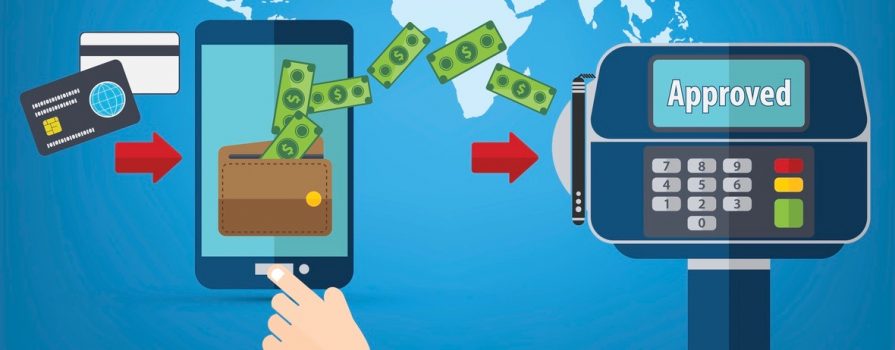Today’s world is all about being able to do a million things at once, with ease. It’s about being able to dine, pay the bill, and trade stocks simultaneously and without human interaction. It’s about being able to order a ride downtown and apply for a home loan at the same time—instantly and effortlessly. It’s about banking while bowling. It’s about being where you aren’t, and rendering time and distance irrelevant.
It’s about convenience. Today’s brands that are trailblazers in mobile tech include Visa, PayPal Holdings, MasterCard Incorporated, Wal-Mart Stores, and Shopify, according to new research from financial analysis firm Safehaven.com.
Mobile apps have very decisively changed the way we live, but this is only the first evolution. There’s more to come, and right now it’s all about FinTech—the computer programs and technology used to support or enable banking, financial and other mobile services.
At stake is the dominance of a massive industry that is fiercely dynamic—and the competition is cutthroat.
FinTech has taken the banking, payment services, digital currency, investing and insurance industries by storm. That’s why FinTech funding hit $19 billion in 2015—with massive growth sped up by legacy players and their tech partners sitting on the cutting edge of business ideas and major first-mover advantage.
In the first half of this year, FinTech companies in the U.S. raised $3.5 billion, according to KPMG. Investors pounced on this scene in droves. And in the U.S. alone, there are more than a dozen FinTech heavyweights with valuations over $1 billion.
According to the annual FinTech Report from PwC, cumulative investment globally will exceed $150 billion in 2017.
As of this year, transaction value in the U.S. FinTech market alone is over $1 trillion. And the largest segment of this market is ‘digital payments’, which did nearly $740 billion in transactions so far this year.

There are some brilliant start-ups out there that have already made it to the billion-dollar club, but we’re still waiting for their IPOs (Robinhood, SoFi, Stripe…). In the meantime, here are 5 stocks already in the billion-dollar club, or nicely poised to make it there—soon.
#1 Visa
Visa’s shares are up over 600 percent since 2008 when it went public. This is a great long-term investment success story for anyone who has the patience. But even year-to-date, shares are up 30%. And it’s making large investments in FinTech—Visa announced recently it is enabling Visa payments on Fitbit’s first smartwatch, Fitbit Ionic. Eligible cardholders of participating banks will be able to make payments with Fitbit Pay, Fitbit’s new payment function, when available. With Fitbit Pay, Visa and Fitbit are meeting demand amongst the majority of wearable owners who, according to the recent “How We Will Pay” survey by PYMNTS and Visa, see the opportunity for wearables to improve the way they pay throughout their day with a more secure and seamless cashless payment experience.
The continuous rise in mobile connectivity has led to the proliferation of digital payments, with Visa helping to offer more ways to pay through devices such as phones, watches and now fitness trackers with the new Fitbit Ionic—no physical wallet required. To make Visa purchases using the Fitbit Ionic device, users simply load an eligible Visa credit or debit card on the Fitbit companion app and hold the smartwatch near an NFC-enabled terminal for a simple and secure way to make purchases on the go.
“Visa continues to focus on delivering the tools and technologies that empower our partners to offer safe, secure and convenient payments to consumers via connected devices,” said Jim McCarthy, executive vice president of innovation and strategic partnerships at Visa Inc., in a news release. “Partnering with Fitbit on its new Fitbit Pay service is another step forward in the growth of Internet of Things and shows how Visa is enabling companies across the technology industry to help us all move towards a cashless future.”
#2 Glance Technologies
This company’s GlancePay app is at the forefront of the mobile payment revolution, with a clear competitive advantage. It’s already the no. 1 mobile payment app in Canada, accounting for over 92 percent of mobile full service restaurant payment app downloads. It’s also making big waves across North America, where it accounts for 37 percent of all mobile full service restaurant payment app downloads.
GlancePay knows where you are by using patent pending GPS technology. And, if GPS isn’t available, it can even determine your location using a photo of where you are. Much like Google has mapped the world, GlancePay has quietly built a proprietary database of locations around the world.
It’s as easy as point, shoot, pay.
But it is also much more. It takes the mobile pay app experience much farther, for both customers and merchants.
With GlancePay, you’re not just paying a bill: The system includes in-app marketing, in-store rewards, transaction history, payment confirmation, and even the ability to split the tab in a restaurant. It incentivizes users… and adoption is picking up from this network effect.
It also helps you choose nearby restaurants, and soon, it will also let you order from your table, pre-order for pickup, or order for delivery. For restaurants, it means better business, faster turnaround and potentially greater revenues.
This isn’t just about making a payment with one click, it’s about streamlining the entire customer experience with a single app-from finding, ordering and paying, to rewards and reviews.
And their plans to provide multiple payment channels from Bitcoin to Litecoin to Ethereum will make the evolution complete.
It could be an incredible opportunity for early investors who understand what’s about to happen.
For example, when Alipay hit the Chinese market with its instant mobile app pay features, it was an overnight sensation. Now, it’s conducting a massive $1.7 trillion in business annually in China.
And GlancePay is casting a much wider net, making inroads in the billion-dollar cannabis industry in a deal that gives them direct ownership in Canapay Financial Inc.
Mobile payment technology is one of the fastest-growing markets in the world, and GlancePay is hoping to be a major market disrupter-filling a gap that not even the trillion-dollar Chinese turnover is filling, or major players on the North American scene.
Launched only in September 2016, Glance Pay already has 230 merchants signed on, and its growth is poised to soar in the coming weeks and months. It’s Q2 revenue is up 664% over the previous quarter.
And this looks like it’s only the beginning:
When the cannabis market takes off in July 2018, it could be one of the biggest things in this dynamic industry yet. Plus, their team is working on Bitcoin (and other cryptocurrency) integration to capitalize on the network effect of this exponentially growing market.
Even better—the co-founder is the very same Vancouver trend-spotter Desmond Griffin who founded PaybyPhone mobile parking payments and sold it for $45 million. Volkswagen owns it now for a nice additional revenue stream.
Bottom Line? In terms of technology, GlancePay has positioned itself right between two giants, on two continents: In the US space, we have Square, which is enjoying a stellar stock price run, but with more of a merchant focus. In China, it’s giant Alipay, which isn’t publicly traded.
GlancePay is eyeing the gap between these two offerings. A sort of Alipay for North America, but with more of Square’s focus on merchants. From another perspective, think Groupon in this space: buying deals, getting digital coupons, but based on smart tech that knows its customers.
This gap GlancePay is seeking to fill is a potentially lucrative one, and it’s moving quickly towards its end goal.
#3 PayPal Holdings
With a market cap of around $72 billion, PayPal is a giant in the mobile transactions segment, and its Venmo app processed a record $6.8 billion in the first quarter of this year. That’s double what it processed in the same period last year. Right now, it’s not clear whether Venmo is a huge revenue earner for PayPal, but it should be in the future.
By 2020, PayPal is expected to see a massive growth in mobile e-commerce, and many feel it is poised to capitalize on mobile e-commerce more than any other company out there. What stands out, in particular, is the fact that last year along, PayPal was responsible for over $100 billion of all payments from mobile devices-and this year should be even more. In the first quarter of this year already, $32 billion in mobile payment volume went through PayPal. That’s a whopping 51% increase year-on-year. PayPal ‘One Touch’ is the key driver of this.
In this segment, breakneck innovation is key, and PayPal’s got it.
Currently trading at around $60, with a 52-week high of $61.30 and a low of $36.30.
#4 Mastercard
Mastercard is proving itself the master of innovation, and it’s been demonstrating this most recently in the areas of convenience and security-this latter is one of the deciding factors in this space.
A major catalyst was its introduction, last year, of “Mastercard Identity Check”, or “Selfie Pay,” which is exactly what it sounds like—you take a picture of yourself with your phone to authenticate a transaction.
Then, this year, it launched its “Decision Intelligence” platform, which is powered by artificial intelligence. This is a critical platform for financial institutions and will make payments even easier and more secure (real-time approvals).
Mastercard is a behemoth when it comes to security, and this is going to a key aspect of the FinTech evolution. But what, you might say, does this have to do with making money? Well, for Mastercard investors, there is revenue in security (as well as data analytics and loyalty programs), and it’s also the company’s fastest growing segment.
In its first quarter, Mastercard’s net revenue was up by 12 percent, while EPS was up by 16 percent over the same period last year.
Right now, this nearly $142 billion market cap company is trading at around $133 per share, with a 52-week high of $133.46 and a low of $131.98. It’s not volatility that a day trader will latch onto, but it’s an excellent long-term growth prospect for investors.
#5 Wal-Mart Stores
When you think of Walmart, you might think of the horrifyingly dull retail business-but think again. Walmart is one of the biggest movers in terms of mobile payment apps, and it’s quite a few steps ahead of others in this respect. It’s even a threat to Amazon’s online shopping dominance, down the road.
The big news is that Walmart and Google are partnering beginning in late September so customers can order groceries from Walmart using Google Assistant or Google Express.
As Wired magazine notes: “While Amazon may have an indomitable hold over your TV and Crocs purchases, it has few inroads into the perishable goods Walmart built an empire out of.”
Amazon’s stocks are already prohibitively expensive, reaching the $1,000 mark recently. Walmart is much more accessible, with room to grow if its gamble with Google works out. Walmart is trading around $78 per share, with a 52-week high of $81.99 and a 52-week low of $65.28.
This is a long-term bet, but considering its forward-thinking success with Walmart Pay-the retailers intuitive and highly functional mobile pay system–and its clear drive to challenge Amazon, we see solid drivers of growth here.
Honorable mention in the FinTech space: Shopify
More than 500,000 companies rely on Shopify’s real-time e-commerce, including Tesla, Budweiser and Red Bull, among many others. Shopify manages their e-commerce machines, and its stock is now up to over $106 right now, with a market cap of over $10 billion.








